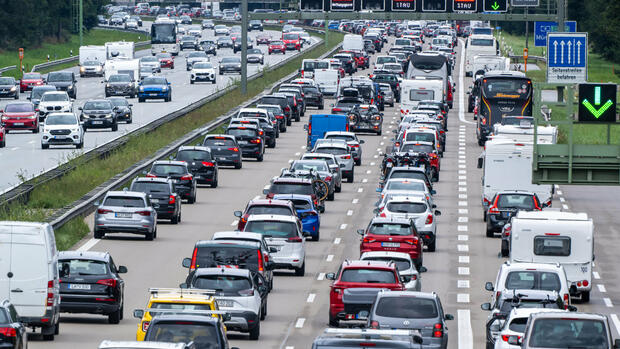Transport Minister Wissing plans to expand 144 sections of the motorway particularly quickly.
(Photo: dpa)
Berlin For Vice-Chancellor Robert Habeck (Greens) there is no doubt: In his home country of Schleswig-Holstein, no motorway should be expanded at an accelerated pace. After all, there was no such project on the list of motorway sections that Transport Minister Volker Wissing (FDP) wants to implement faster by law in the future and that he presented to the coalition meeting at the end of March.
But when the law was supposed to go into the cabinet at the beginning of May, there was one section on the list: the A 23 in the Pinneberg district. Habeck vetoed it, only without the A 23 would he agree to the Acceleration Act.
Wissing gave in so that the law could finally be passed. After all, the FDP had been negotiating with the Greens for months so that infrastructure projects could be planned and approved as quickly as wind turbines had been since spring 2022. But then the dispute over the roads had started and so far slowed down what was actually supposed to be accelerated.
Minister Wissing wants to expand a number of autobahn sections at high speed with the argument of “outstanding public interest”. His list includes 144 measures, which are derived from the Federal Transport Infrastructure Plan. The SPD, Greens and FDP also referred to this in their coalition decision: According to this, it is about motorway projects that are either marked as particularly urgent, so that bottlenecks and traffic jams come to an end. Or there are so-called already scheduled projects that also help to eliminate bottlenecks.
And yet the list is in the world and is causing trouble and confusion, not only between the Greens and the FDP, but also in the federal states. Finally, countries should review the projects on the list and give them the go-ahead for accelerated implementation. The A 23 was also on the list that the state government in Kiel checked and confirmed. After all, the Federal Transport Infrastructure Plan from 2016 sees an urgent need for the motorway section.
In a letter to Wissing, State Transport Minister Claus Madsen protests that the A 23 should no longer be included. He asked “for an explanation of this, in my view, non-transparent and ultimately inefficient procedure,” as the non-party minister writes. The letter is available to the Handelsblatt.
A 42 instead of A 23: Arbitrary motorway expansion?
It is incomprehensible why the A 23 should not be built faster. Instead, even a section of the A 42 between Bottrop and Essen was subsequently added to the list, Madsen complains.
In fact: Like the A 23, the section of the A 42 was no longer on the project list. This was confirmed by a spokesman for Minister Wissing. He emphasized: It’s not about lists, but about the categories of the traffic route plan. The only exception is the A 23 in view of Minister Habeck’s special request.
The Transport Minister of Schleswig-Holstein criticizes the decision that the A 23 should apparently not be expanded at an accelerated rate.
(Photo: IMAGO/Chris Emil Janssen)
The A 42 was not on the list of 144 motorway sections, although there is an urgent need for it. Other sections in NRW were also missing. State Transport Minister Oliver Krischer (Greens) Wissing had already drawn attention to this in a letter and speculated that the list was “obviously primarily negotiated politically”. However, it was obviously unclear how far the planning for the projects had progressed and whether it would still help to speed up the process.
Madsen speaks of “unequal treatment”: In the case of the A 23, a Federal Minister of the Greens ensures that a bottleneck in the motorway network is removed from the list, while in the case of the A 42, a Green State Minister’s tip ensures that a project is back on the list is added – with reference to the categories. “I hope for your support that the A 23 will be treated in the same way as all other bottleneck removal measures and will still be included in the list,” Madsen writes to Wissing.
Where does the number 144 come from?
However, the Federal Minister’s list still raises questions. In the transport route plan there are not 144 bottlenecks, but only 111 projects: 99 bottlenecks in urgent need, twelve scheduled. Since some sections are already under construction, even fewer than 111 measures can be considered, which are now to be given preferential treatment and implemented by law through the labeling of “overriding public interest”.
Then why 144? The spokesman for the Ministry of Transport pointed out that projects had been split up if they went through several federal states. However, there are projects mentioned up to eight times that do not even lead through several federal states – for example in Hesse from Haiger to Gambach. On top of that: The traffic route plan already lists the sections by federal state. Some questions about the acceleration law remain unanswered.
More: Wissing wants to build motorways faster – also for military emergencies
